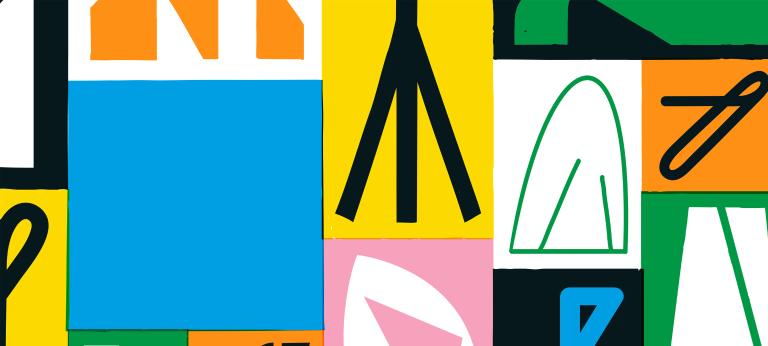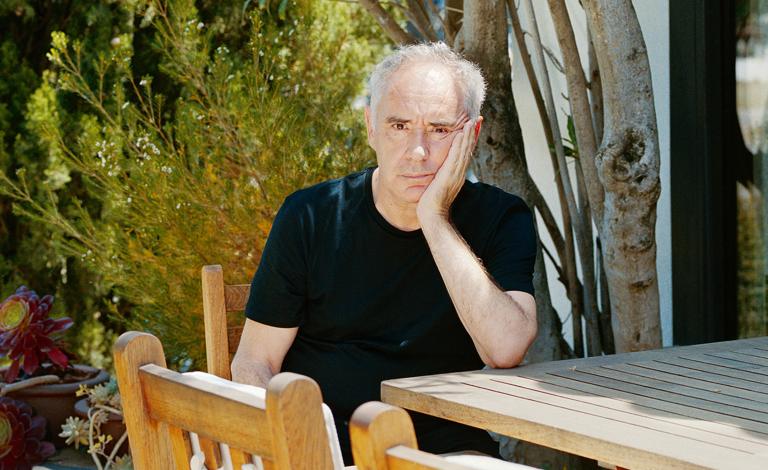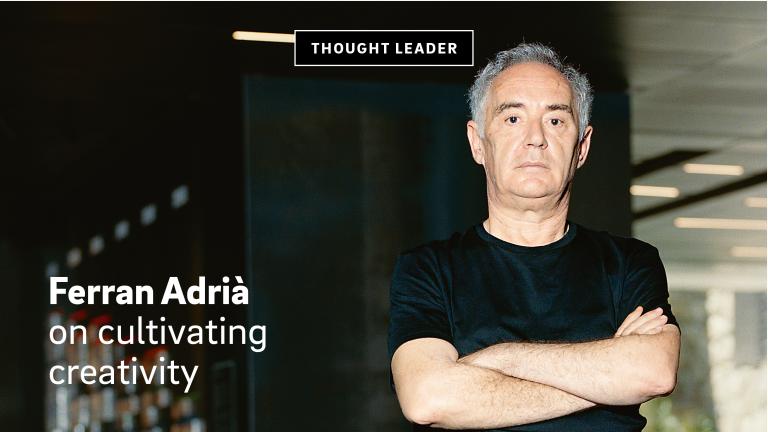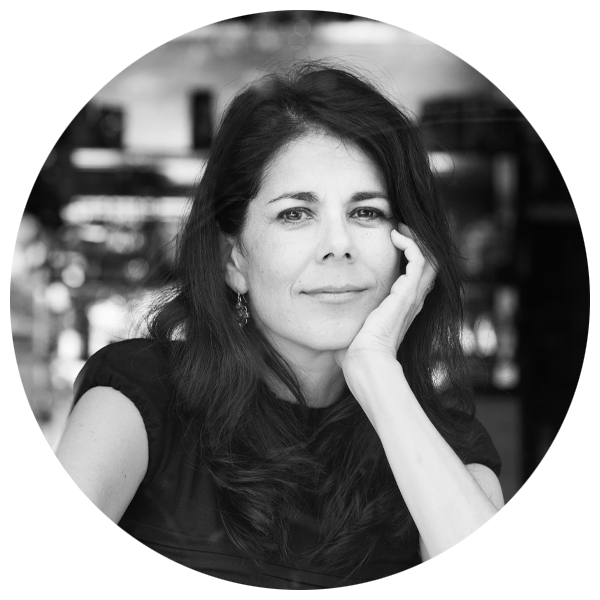Art and Business
![{[downloads[language].preview]}](https://www.rolandberger.com/publications/publication_image/TA38_EN_Covers_1_FINAL_download_preview.jpg)
The arts have much to offer for improving business strategies. Think:Act calls on seasoned artists to help business leaders unlock their creative side.



He pioneered a new gastronomy and his restaurant was considered the best in the world. But what was the secret to the El Bulli founder and visionary chef's success? Creative imagination, bravery and a clear desire not to repeat himself. We meet Ferran Adrià and gather his thoughts on why cooking is an art and how innovation matters.
The perpetually sparkling waters off Cala Montjoi in the northeastern corner of Spain are even more dazzling than usual on this particular June morning. Ferran Adrià stands outside in his trademark black t-shirt and black trousers and watches as a small group of similarly black-clad men screw industrial tubing into something that looks half switchboard, half jungle gym. It is, in fact, neither of these things. It's art. A sculpture, in fact, intended to visualize the synaptic processes that link sensory reception and the human brain. "Welcome," Adrià says by way of introduction, "to the Forest of Creativity."
Ferran Adrià began his culinary career at age 19 after being drafted into military service and working as a cook. He joined El Bulli as a line cook at the age of 22 in 1984, becoming the head chef 18 months later. Often eschewing the label "molecular gastronomy" to describe his creations, Adrià calls his cooking "deconstructivist" and has compared the experience of having dined at El Bulli as being akin to a night at the theater.
In some ways, that's what El Bulli has always been, at least since the mid-1980s, a few years after Adrià, an intensely energetic man whose restlessness extends even to the remarkable speed with which he speaks, had become head chef at the tiny restaurant on Spain's Catalan coast. Driven, he says, by a desire "not to get bored," he began experiments with cuisine that would, in time, lead to nothing short of a gastronomic revolution – one that redefined not only the experience of the diner, but also expanded what it meant to be a chef.
What was at first one very quirky query – Question: What happens if we attach a bicycle pump to a tomato and fill it with air? Answer: It explodes ... but first, it foams – would soon open the door to a host of inquiries that interrogated every assumption about food and fine dining: Why does dessert come after the savory courses? Why does a soup have to be liquid? Why is it rude to eat with your hands? Why can't ice cream be hot?
Seated on the same whitewashed patio where guests once enjoyed edible cocktails as they gazed out onto the bay, Adrià, his head of curls now gray, speaks eloquently about his restaurant's trajectory. "At first, we didn't know why we were experimenting – it was more visceral than rational," he says. "But we went from that very naive position to asking why, and then from why to who, what, where and when as well."
The questioning would lead to dramatic new cooking techniques and dishes – "caviar" made from globules of mango juice; an edible paper made from cotton candy; spaghetti made from squiggles of parmesan sauce, lots and lots of foams – and give the world a new style of cuisine with the unlovely (not to mention, unloved) name of "molecular gastronomy." It would also push Adrià and his team to reinvent other aspects of how restaurants are run, from service to staffing to financing. "People always talked about El Bulli's techniques, about deconstruction, spherification [a characteristic El Bulli technique that turns liquids into semi-solid globules]," he says. "But no one talked about how we stopped serving bread as an accompaniment to the meal. For me, though, that was much more important because it changed the paradigm."

Perhaps the most important part of the El Bulli revolution – and the one with the most relevance to fields outside of cuisine – was the emphasis it put on creativity. Where chefs in the past had been positioned as craftspeople, responsible for faithfully reproducing the same dishes night after night, Adrià privileged imagination. And then he staked his restaurant on it: By the end of the 20th century, the restaurant had instituted a lengthy tasting menu whose 35-plus courses would be utterly reinvented from one season to the next. No longer did diners – at least those lucky enough to snap up a reservation among the 2 million who tried each year – return to El Bulli hoping to repeat a favored dish; now they came to see what was new.
10,000 PAGES: The number of pages in the El Bulli General Catalogue, which documents all the dishes served at El Bulli Restaurant from 1987 until it closed in 2011.
By the time the restaurant closed in 2011, El Bulli had topped the World's 50 Best Restaurants list a then-unprecedented five times and Adrià had confirmed his place as one of history's most influential chefs. Since then, he has been working to transform El Bulli into a foundation with a museum devoted to the restaurant's legacy and hosted residencies that will bring together leaders in different disciplines to work on collaborative projects. It, along with that Forest of Creativity, a kind of sculpture garden devoted to the mechanics of the creative process, is scheduled to open to the public in 2023.
Adrià's interest in creativity all started, he says, with the simplest of maxims. When he was dining in the renowned restaurant Negresco with a few Spanish colleagues, someone asked chef Jacques Maximin how he defined creativity. "He said, 'to create is not to copy,'" says Adrià, recalling the lightbulb moment. "And that was the beginning of everything: 'don't copy.'"
At El Bulli, they applied the maxim to extend to not copying their own work as much as anyone else's. The kitchen replaced à la carte menus with a 35-plus course tasting menu that changed completely each season – a transformation that required roughly 100 new dishes each year. Maintaining that pace of invention, the team at El Bulli soon realized, would require a revision of common understanding of the creative process. Rather than relying on inspirational lightning to strike or the muse to declare herself, they would need a system to reliably foster new creations. That system required some dramatic changes. Although it is now fairly common for ambitious restaurants to keep a separate test kitchen for developing new recipes, when El Bulli opened its "workshop," as they called it, it was an unprecedented move. So too was the decision to close the restaurant six months of the year so that they could work on innovation. But some of the most effective measures were also the most mundane. "Documentation was fundamental," Adrià says, referring to the reams of notes and files of photos that the team took of their work. "We catalogued everything – every recipe and technique we tested, failures as well as successes. That way, we could always go back to things that hadn't quite worked out and try them in new ways. And we created so much that we needed the catalogue to remember what we had done. The documentation helped ensure we weren't copying ourselves."

And because El Bulli wasn't just developing ideas but serving them nightly to paying guests, it also meant reconciling the drama and excitement of the new with the tedious work of, say, squeezing drops of mango juice into a solution to create each sphere of "caviar" or extracting the germ from kernels for a corn "risotto." "There is a relationship between the creative and the mechanical," Adrià explains. "It's the same with painters – think of all the mechanical work that went into a Picasso painting. There's always something routine inside creation."
"To create is not to copy. And that was the beginning of everything: don’t copy."
The reference to Picasso isn't random. Adrià was frequently compared to the artist because his work was so groundbreaking – and perhaps more than any other chef in history he had considered the question of whether food could also be an art form. In 2007, in fact, he was invited to the renowned documenta contemporary art fair as guest artist. Convinced that his authentic work could only be experienced in his restaurant, his contribution had him flying two of documenta's visitors to El Bulli for dinner each night.
That notion taps into his essential belief that creativity is something that can be learned. "It's true that creative talent matters, especially if you're working at the maximum level, where you're trying to change paradigms," he says. "But you can also train it, you can improve it," he says. It's exactly what Malcolm Gladwell said about the 10,000 hours – you train it by doing."
These are the kinds of questions that Adrià and his team have been exploring since closing El Bulli as a restaurant and transforming it into something that, in its own way, is just as unprecedented. They've spent the last decade developing a methodology, called Sapiens, for thinking comprehensively about cuisine, and then using it to compile an encyclopedia – the Bullipedia – of gastronomic knowledge. "In a certain way, we did it to explain ourselves to ourselves," Adrià says. "We had to create a method of understanding what we did."
When the El Bulli museum opens in 2023, complete with a high-tech visual history of the restaurant's dishes, a spectacular conference room that looks like it was transported from Tolkien's Middle Earth and those weird and wonderful sculptures overlooking the bay, it will make concrete the otherwise ephemeral legacy of El Bulli and the man, now 60, who made it the most innovative restaurant of all time. When he looks back on what allowed him to achieve what he did and maintain that incessant creative energy across decades, he comes up with a three-part formula: respect and admiration for the team that helped him realize the vision, serious effort as manifest in all those hours of work testing and retesting and, then, that ineffable sprinkling of talent.
But asked how others in different fields might also remain open to constant change, he remembers a fourth pillar. "You have to be brave. Ninety-nine percent of the businesses out there don't innovate; they just adapt models that are already successful. If you want to truly innovate, being brave is the most important thing."

![{[downloads[language].preview]}](https://www.rolandberger.com/publications/publication_image/TA38_EN_Covers_1_FINAL_download_preview.jpg)
The arts have much to offer for improving business strategies. Think:Act calls on seasoned artists to help business leaders unlock their creative side.
